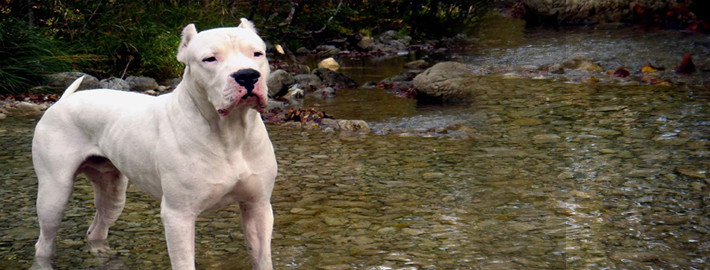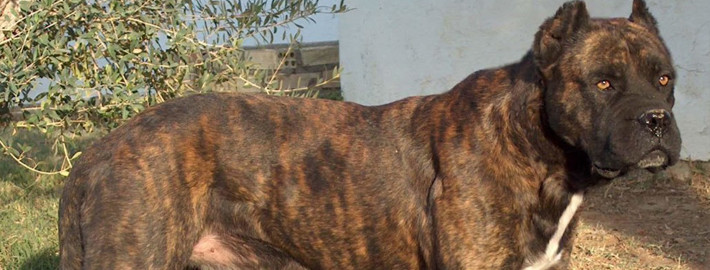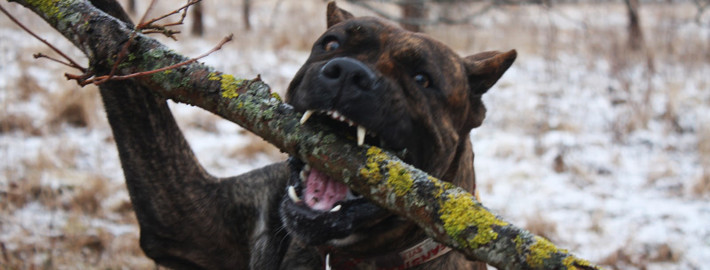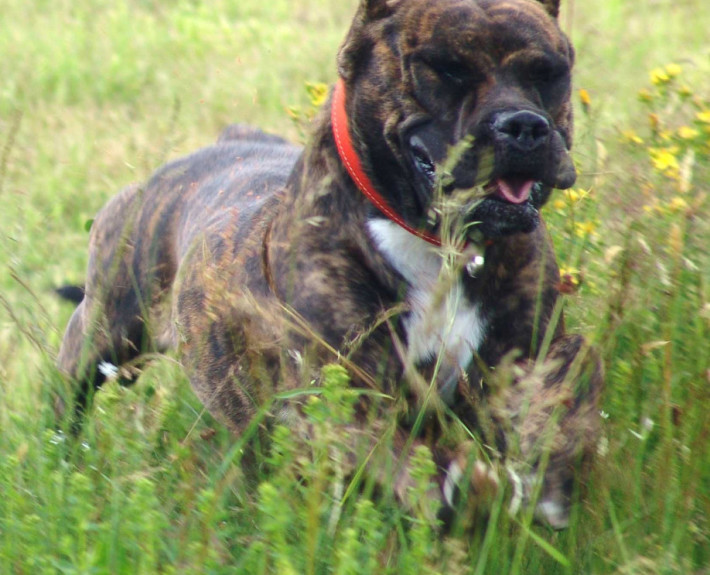What makes the Alano Español Unique?
Although this rare breed is not suitable for apartment life, the athletic Alano Español is a dog of historic significance and giant proportions.
Breed Groups
Page Contents
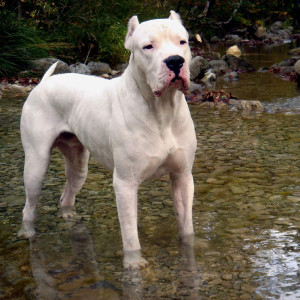
SnapShot
Is the Alano Español Right For You?
Alano Español, sometimes called the Spanish Bulldog in English, is a large breed of dog of the molosser dog type, originating in Spain. The breed is best known for its former use during Spanish bullfights. It has a primitive appearance whose general physiology fits him especially well for running at high speeds for long periods of time and firmly holding wild game or cattle for a long time when ordered. With a well-proportioned body structure, the rib cage is arched, not cylindrical, the chest reaches elbow level, with strong and solid shoulders and withers. The front legs are stronger than the back ones, and are straight whether viewed from the front or from the side. The paws are generally much larger than those of other dogs of the same size and weight.
In 5 Words
- Aggressive
- Well mannered
- Obedient
- Sociable
- Dominant
Characteristics
Learn About the Alano Español
Description
General Description
Although earlier versions may have been thought beautiful by contemporary sources, these working dogs were initially bred for stamina and skill rather than a uniform appearance. The Alano Espanol has a proportionate body with an arched rib cage and a large chest. Their square heads and short muzzles are their other defining features. These dogs overall have a muscular and powerful appearance.
Size
In general, males of this breed are slightly larger than the females. Reports of their size vary with the average being about 84 pounds in weight and 24 inches in height.
Coat
These dogs have short, stiff fur. They come in a variety of colors including red, fawn, black, and grey. A good many of these dogs are brindled. White patches are perfectly acceptable on these dogs but they should not dominate the dog’s fur. Masks are likewise permitted.
Short History of the Alano Español
This breed dates back to around the 5th century when a tribe called the Alani moved from the Byzantine Empire into what is now France and later Spain. Their pets were a formidable type of dog that were using for both managing livestock and hunting. These dogs were mentioned in works dating back to the Middle Ages. In his Book of the Hunt of Alfonso XI, the 11th Count of Foix described the personalities of the Alani’s dogs in somewhat unflattering terms, but goes on to state that the same animals had beautiful colors.
Spanish explorers that were on their way to the Americas took the descendants of these dogs along with them. In the New World, these more modern Alano ancestors regained their earlier reputation as war dogs. This breed proved itself to be intelligent and brave in battle against the native populace. When bullfighting later became popular in Spain, these dogs would find themselves matching wits with much larger animals rather than poorly equipped human beings.
These dogs remained popular until the 1800s when improved machinery began to infringe on their traditional occupations. When bullfighting was eventually banned, this breed was left without an obvious task to perform and the population dwindled. For a time, the Alano Espanol was thought to be extinct until that was discovered to not actually be the case. About 300 of these dogs were found living in rural provinces of Spain that had changed little over the course of the centuries. The desire to protect this rare breed eventually led the creation of a breed standard.
Although the Alano Espanols is often treated as being interchangeable with the Spanish Bulldog (Perro de Toro), breed fanciers of either type might insisted there some subtle differences in the appearance of the two. Adding to the confusion is the fact that the two breeds are occasionally bred together by those who regard them as the same breed but kept separate by those who do not agree with this practice.
Temperament
Due to their dominant natures and occasionally bellicose mannerisms, this breed is not recommended for amateur dog owners. Alano Espanols are nonetheless obedient and well behaved under the right leadership. However, these dogs are also known to be loyal to their entire families not just one member in particular. They are also fairly good with but supervised playtime is best because this large breed could easily knock over a small child.
As their ancestors hunted in packs, this breed is generally considered to be canine friendly but they may still show some issues with dominance over members of the same gender. While they do not usually misbehave around other dogs, they do not react well to being challenged by them. This breed is also not recommended for households that container smaller pets such as gerbils or cats.
Their incredibly protective nature makes Alano Espanols wary of unfamiliar people and they will certainly challenge strangers. Persons who unknowingly enter the dog’s territory may even be attacked without any warning. Therefore, an Alano Espanol should be kept in a securely fenced area, especially when members of their family are not home.
Caring for Your Alano Español
General Health
Living about 12.5 years on average, these dogs don’t have a lot of health concerns for prospective owners to worry about. However, there have been occasional instances of Alanos suffering from hip dysplasia. These working dogs have a history of being able survive rough conditions, which may account for the Alano Español’s general good health and disease resistance.
Care
Daily
Plentiful exercise is a must for this breed. Even non-working dogs of this breed prefer the countryside with its wide open spaces where they can run off some of their boundless energy. Otherwise, they will need to be walked about three times a day with one of these excursions being a lengthy stroll through an open area.
Weekly
Regularly cleaning the teeth of one’s dog can help reduce instances of dog breath
Monthly
All breeds of dog require regular flea, tick, and heartworm medication. These are usually administered on a monthly basis.
Grooming & Bathing
These dogs do not need copious amounts of grooming, but owners can certainly comb their Alano Espanols every so often with a rubber brush if they wish to do so. Alano Espanols will only need to be bathed in the event that they become exceptionally dirty or if they encounter a skunk.
Exercise & Training
This breed benefits greatly from constant training throughout the course of their lives and, once properly educated, they are incredibly obedient. However, Alano Espanol dogs can be difficult to housebreak and should spend most of their time outdoors as a result. This is no hardship because these hardy dogs were bred for outdoor life and are badly suited to being stuck indoors. Both cold and heat pose no problem to these dogs, as they would much prefer to carry on their lives without being trapped in the confines of a household. Those Alano Espanols that are nonetheless regulated to the status of family pet will need to be regularly exercised to prevent destructive behaviors.

